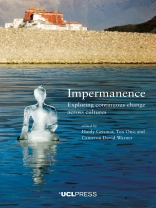Nothing lasts forever. This common experience is the source of much anxiety but also hope. The concept of impermanence or continuous change opens up a range of timely questions and discussions that speak to globally shared experiences of transformation and concerns for the future. Impermanence engages with an emergent body of social theory emphasizing flux and transformation, and brings this into a dialogue with other traditions of thought and practice, notably Buddhism that has sustained a long-lasting and sophisticated meditation on impermanence.
In cases drawn from all over the world, this volume investigates the significance of impermanence in such diverse contexts as social death, atheism, alcoholism, migration, ritual, fashion, oncology, museums, cultural heritage and art. The authors draw on a wide range of disciplines, including anthropology, archaeology, art history, Buddhist studies, cultural geography and museology. This volume also includes numerous photographs, artworks and poems that evocatively communicate notions and experiences of impermanence.
Praise for Impermanence
‘This collection of multi-disciplinary case studies takes an exciting comparative view of how impermanence is experienced in cultures and societies across the globe.’
Religious Studies Review
‘All chapters are well annotated and come with an extensive bibliography that seasoned scholars, as well as students interested in social theory, anthropology, philosophy, and Buddhist studies, will find very useful. Even general readers might find some of the essays interesting. Each chapter has comprehensive explanatory notes and is wellreferenced and the volume also has an index which is equally helpful to wade through key concepts and unfamiliar names. This book undoubtedly deserves a place in all university libraries.’
Journal of World Buddhist Cultures
‘Impermanence? Nothing in life can originate or grow without other things’ perishing. But to call this “impermanence” is to pit the passage of life against the human desire to keep. The creative tension between living and keeping, between generation and conservation, even between metabolism and culture, runs through all the chapters of this book. They touch on matters of life and death, of care and curation, of holding on and letting go, in settings ranging from family and religious life to art-making and museum exhibition. With so much original thinking lovingly conserved on its pages, the book powerfully exemplifies the many paradoxes of which it speaks.’
Tim Ingold, University of Aberdeen
‘Impermanence emerges as a generative lens in this ground-breaking volume that draws on Buddhist insight into the core constancy of change to push theoretical boundaries across multiple disciplines and chart new ways of engaging material and cultural worlds. Drawing on ethnographic case studies and innovative museum practices to undermine fixities of all sorts, the chapters will inspire vital debate and experimentation.’
Lauren Leve, University of North Carolina at Chapel Hill
‘This volume is an important addition to a new analytical trend of focusing on, rather than eliding, the materiality of ruination and decomposition in social life. It does so through a fusion of Buddhist thought on impermanence with a number of Western analytic traditions. The result is a series of theoretically and empirically illuminating, and highly stimulating, chapters.’
Ghassan Hage, University of Melbourne
Table des matières
List of figures
List of contributors
1 Introduction
Haidy Geismar, Ton Otto and Cameron David Warner
Part 1: Living with and against impermanence
2 Heavy curtains and deep sleep within darkness
Tsering Woeser
3 Disinheriting social death: towards an ethnographic theory of impermanence
Carole Mc Granahan
4 Atheist endings: imagining having been in contemporary Kyrgyzstan
Maria Louw
5 Encountering impermanence, making change: a case study of attachment and alcoholism in Thailand
Julia Cassaniti
6 Holding on and letting go: Tanzanian Indians’ responses to impermanence
Cecil Marie Schou PallesenPart 2 States of being and becoming
7 A Melanesian impermanence
Joe Nalo
8 ‘We are not an emblem’: impermanence and materiality in Asmat lifeworlds
Anna-Karina Hermkens and Jaap Timmer
9 The unmaking and remaking of cultural worlds: reinventing ritual on Baluan Island, Papua New Guinea
Ton Otto
10 ‘Do what you think about’: fashionable responses to the end of Tibet
Cameron David Warner
Part 3: Structures and practices of care
11 Negotiating impermanence: care and the medical imaginary among people with cancer
Henry Llewellyn
12 Caring for the social (in museums)
Haidy Geismar
13 Transitional sites and ‘material memory’: impermanence and Ireland’s derelict Magdalene Laundries
Laura Mc Atackney
14 Photos and artist statement
Alison Lowry
Part 4: Curating impermanence
15 ‘Neurosis of the sterile egg’ – permanence and paradox: museum strategies for the representation of Gustav Metzger’s auto-destructive art
Pip Laurenson and Lucy Bayley
16 Culturing impermanence at the museum: the metabolic collection
Martin Grünfeld
17 Screenshooting impermanence
Winnie Soon and Sarah Schorr
18 ‘Museum of Impermanence’: the making of an exhibition
Ulrik Høj Johnsen, Ton Otto and Cameron David Warner
19 Epilogue: self unhinged
Caitlin De Silvey
Index
A propos de l’auteur
Cameron David Warner is Associate Professor of Anthropology who studies Tibet, Nepal and the Himalayas.












